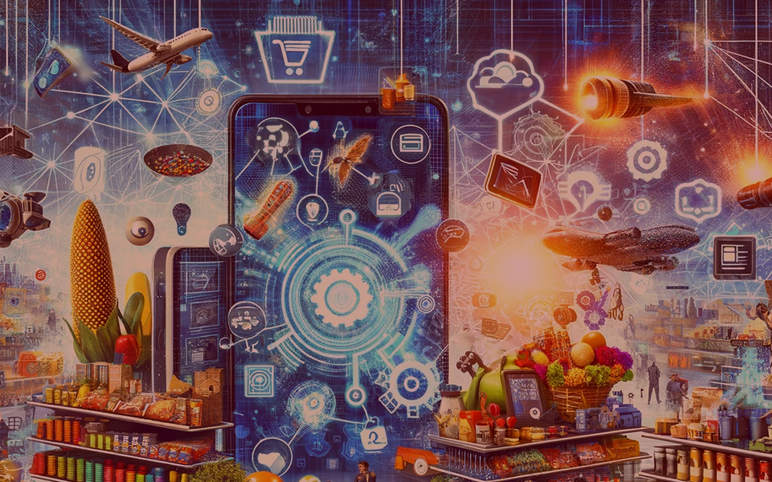In an era where the digitalization has
become as critical as the physical, the imperatives for consumer staples
companies to expand their e-commerce capabilities and enhance their digital
presence can't be overstated. As an industry expert with years of experience
observing and guiding businesses in the consumer staples sector, I've seen
first-hand the transformative impact of e-commerce on traditional business
models and the immense potential it holds for those willing to adapt and
innovate.
The Digital Inflection Point
The convergence of digital technology and
retail has reached a watershed moment. It’s an inflection point driven by the
acceleration of online shopping behaviors; a trend significantly catalyzed by
the COVID-19 pandemic. The figures speak volumes: A study by UNCTAD reported a
rise from 16% to 19% in global e-retail sales in 2022 alone, and this is just
the beginning.
For consumer staples companies, this isn’t
a fleeting change but a permanent shift in the consumption paradigm. The
digital presence is no longer supplementary—it's central to strategy. The
consumer's path to purchase is increasingly online, and brands must be present
across that journey.
Reinventing the Wheel: E-Commerce as the New Storefront
The storefront has evolved beyond physical space to encompass the digital landscape. This transition means rethinking product accessibility, customer experience, and logistical operations.
- Product Accessibility
Consumer staples cover the spectrum of essential goods, from food and beverages to household products. The e-commerce platform has to ensure that the online shopping experience is not just a replication of the physical store but an enhancement. Availability is key. A ‘stock out’ online can be more detrimental than in a physical outlet due to the immediacy with which consumers can seek alternatives.
- Customer Experience
The online customer experience is nuanced. It's about creating a user interface that is both intuitive and engaging. The goal is to translate the tactile satisfaction of in-store shopping into a digital format. It’s about leveraging data analytics to personalize experiences, from product recommendations to customized promotions.
- Logistical Operations
Efficiency is the backbone of e-commerce.
The ability to deliver quickly and reliably can be the difference between
customer retention and loss. This means investing in smart supply chains,
predictive logistics, and possibly, futuristic delivery methods like drones or
autonomous vehicles.
Building the Digital Ecosystem
Expanding digital presence means creating an ecosystem that seamlessly integrates various digital touchpoints.
- Websites and Mobile Apps
Your website and mobile app are likely the first points of interaction with the consumer. They need to be more than just catalogues. They should offer valuable content, interactive features, and real-time support. Augmented reality (AR) features, for instance, can bring products to life in the consumer's environment before purchase.
- Social Media
Social media isn’t just for promotion; it’s a community space. It’s where brands can build rapport with consumers through engaging content, responsive communication, and community-building activities. This platform is also vital for tapping into influencer marketing and harnessing user-generated content.
- Marketplaces and Omnichannel Strategy
Consumer staples companies must look beyond
their channels and leverage third-party marketplaces to expand reach. The
omnichannel strategy ensures presence wherever the consumer is, be it on
Amazon, grocery delivery apps, or direct-to-consumer (DTC) models.
The Data Advantage
E-commerce opens up a treasure trove of
data that can drive strategic decision-making.
Consumer Insights
Data analytics can reveal consumer buying patterns, preferences, and behaviors, allowing companies to tailor their product offerings and marketing strategies with precision.
- Supply Chain Efficiency: Real-time data can enable smarter inventory management, reducing waste and ensuring products are in the right place at the right time.
- Dynamic Pricing: Algorithmic pricing can optimize pricing strategies in real-time based on factors like demand, competition, and market conditions.
- Driving Innovation: Innovation is at the heart of expanding digital capabilities.
- Product Innovation: The digital sphere allows for rapid testing and feedback on new products. Crowdsourcing ideas and virtual focus groups can make R&D more consumer-centric.
- Process Innovation: Technological advances like blockchain for traceability, AI for customer service (through chatbots), and machine learning for demand forecasting can streamline processes and enhance consumer trust and satisfaction.
- Business Model Innovation: Subscription services, personalized nutrition, and other DTC models provide opportunities to diversify revenue streams and deepen consumer relationships.
The Human Touch in a Digital World
In our rush towards digitalization, the human element remains indispensable.
- Customer Service: AI can handle routine inquiries, but complex issues still need a human touch. The empathy and problem-solving abilities of a human agent can turn a customer service interaction into a loyalty-building opportunity.
- Trust and Security: As cyber threats loom larger, companies must prioritize consumer trust by investing in robust cybersecurity measures and transparent data practices.
- Community Engagement: Online platforms should facilitate a sense of community. Engaging with consumers through forums, feedback loops, and co-creation initiatives can build a loyal customer base.
Navigating the Challenges
The move to e-commerce is not without its hurdles.
- Regulatory Compliance: The digital domain comes with a web of regulations that vary by region. Companies must navigate data privacy laws, digital taxation, and e-commerce regulations.
- Digital Divide: Not all consumers have equal access to digital platforms. Bridging this gap is essential to avoid marginalizing segments of the market.
- Sustainable Practices: The environmental impact of increased packaging and delivery frequency calls for innovative solutions in sustainable logistics and packaging.
The Road Ahead
The future is both thrilling and daunting.
It holds the promise of virtual supermarkets, personalized shopping experiences
powered by AI, and a seamless blend of physical and digital retail that we're
only beginning to imagine.
For consumer staples companies, expanding
e-commerce capabilities and digital presence is not just about keeping pace
with change—it’s about embracing it, leading it, and leveraging it to build
enduring relationships with consumers. It’s about being where the consumer is,
understanding what they seek, and delivering it in ways that are easier,
faster, and more meaningful than ever before.
In short, the digital transformation is not
a choice but a necessity. The right strategies, technologies, and mindset can
turn this challenge into the most significant opportunity for growth in the
consumer staples sector. It is time for companies to step up and reimagine the
future, shaping the marketplace with innovation, efficiency, and a
consumer-first approach.
Harnessing the Power of Diverse Global Insights and Revolutionary Research Techniques
At Astute Connect, we pride ourselves on our global market research teams, whose diverse expertise spans continents and industries. Our innovative methodologies and unique perspectives converge to deliver bespoke solutions, tailored to meet every nuance of your business needs, ensuring not just growth, but a trajectory towards industry leadership
Contact Us
.png)

